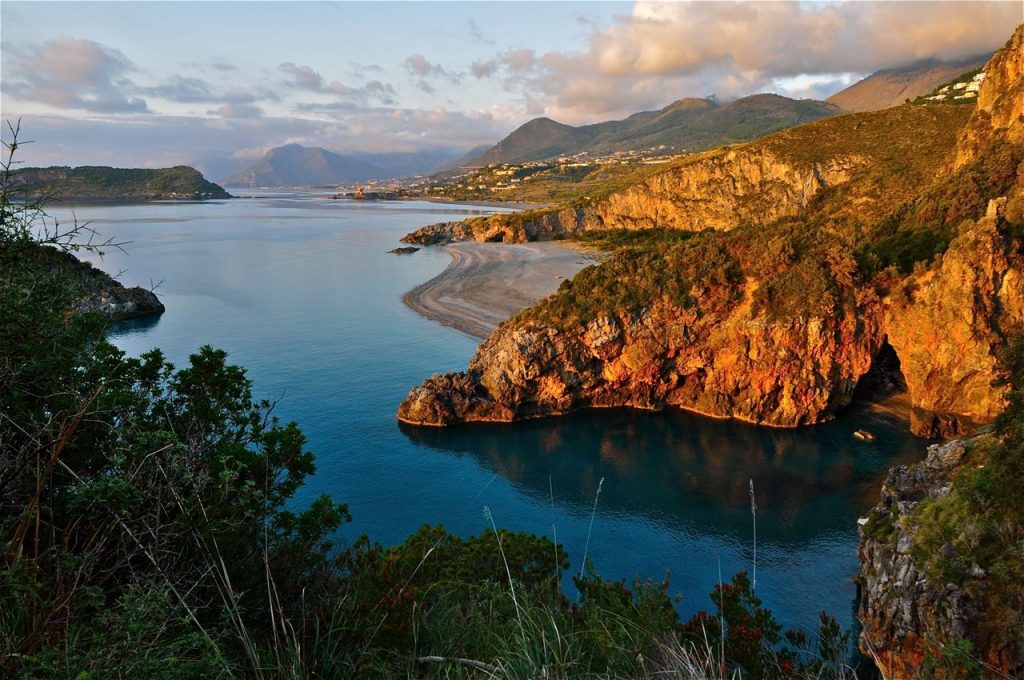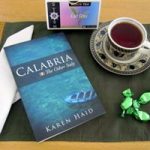What 19th-century American writer set 20 novels, a short story, 5 non-fiction works and a play in Italy? Prolific, imaginative, romantic, entertaining and fantastical, the born storyteller possessed a firm grasp of Italian culture, a sensitivity to character and a penchant for the bizarre. But alas, he is nearly forgotten. Francis Marion Crawford, who traveled the world over and made his home in Italy, immersing himself in the way of life, put his stories to paper for his generation, and dear reader, perhaps even for those to come.
THE CRAWFORD TOWER IN CALABRIA

Torre Crawford in San Nicola Arcella, Photo © Stefano Contin (https://www.flickr.com/photos/stefanocontin)
Francis Marion Crawford (1854-1909) first came to my attention in a meaningful way through the tower named after him in Calabria, the Torre Crawford. Driving the coastal road south along the Tyrrhenian Sea, the tower can be spotted just over the border of Basilicata into Calabria. First comes Dino Island off Praia a Mare and then the tower that sits on a spit of land sticking out into the bay in the town of San Nicola Arcella.
Locals refer to the tower by the name of the author as he not only lived in it but set what was to become one of his most enduring short stories there, “For the Blood is the Life.” In her memoir Italian Yesterdays, his sister referred to the tower as “inconveniently isolated” and said, “My dear brother Marion could never resist the call of fortressed solitudes…. He went there alone, to rest from everything connected with modern life, and he found it a fine, quiet place for writing…”
ARCO MAGNO IN SAN NICOLA ARCELLA

Arco Magno in San Nicola Arcella, Calabria, Photo © Stefano Contin (https://www.flickr.com/photos/stefanocontin)
Even today, the tower may seem isolated for a good part of the year. However, during the warmer months, the spectacular natural setting draws tourists from all over the world, particularly the beautiful beach and the grand natural arch, called Arco Magno in Italian.
Crawford’s connection with Calabria led to my writing a piece about the tower and one of the author’s fantastical stories for the National Italian American Foundation’s Ambassador magazine. The article gives more information about his life and his connection with Italy, particularly its southern regions, in which he had his principal residence on the Sorrentine peninsula. The full text with pictures can be read by clicking on this photo of the article.

“In His Blood” by Karen Haid, Article in the Ambassador Magazine of the National Italian American Foundation
WRITER FRANCIS MARION CRAWFORD
Although Francis Marion Crawford is principally remembered as a master of fantastical literature, that portion of his vast output is quite small, limited to a handful of horror and ghost stories, such as his well-known short works “The Upper Birth,” “Man Overboard!” and the above mentioned “For the Blood is the Life.” His writings that depict Italian life and culture, however, are much more numerous.
The great writer Robert Louis Stevenson was an admirer of Crawford and in a letter penned to him in 1890, even signed it as such:
…. I am now surrounded by your work, and in the middle of With the Immortals. It is reviving to me to know I have a contemporary of your strength though I suppose you are younger, as I hope you will soar higher and farther than
Your admirer, Robert Louis Stevenson.

Doorway in San Nicola Arcella, Calabria. Photo © Stefano Contin (https://www.flickr.com/photos/stefanocontin)
Arthur Hobson Quinn, writing of Crawford in his American Fiction: An Historical and Critical Survey (1951) praised his works about Italy:
His most significant achievement, one in which he has not been surpassed by any writer in English, lay in the novels dealing with Italian life. This is not surprising, since he knew that life well in its social, political, and economic phases. His large library dealing with Italy was collected to serve the great ambition of his life, never realized, of writing a definitive history of Italy.
Although over half a century has passed since Quinn made this assessment, Crawford’s knowledge of and dedication to Italy are clear.
ITALIAN NOVELS OF FRANCIS MARION CRAWFORD

The grotto of Arco Magno, Photo © Stefano Contin (https://www.flickr.com/photos/stefanocontin)
The following is a list of Francis Marion Crawford’s novels that take place in Italy. Good, comprehensive libraries will have many if not all of his works. Free online reading or downloads are also available through Project Gutenberg or the Open Library.
To Leeward (1884) — Rome, Sorrento, Castellamare, Naples, Genoa, Turin
A Roman Singer (1884) — Rome, Palestrina, Filettino (Abruzzo)
Saracinesca (1887) — Rome, Aquila
Marzio’s Crucifix (1887) — Rome
With the Immortals (1888) — Amalfi
Sant’Ilario (1889) — Rome, sequel to Saracinesca
Don Orsino (1892) — Rome, sequel to Sant’Ilario
The Children of the King (1893) — Gulf of Salerno, area around Torre Crawford, Sorrento
Pietro Ghisleri (1893) — Rome and nearby Gerano
Casa Braccio (1895) — Subiaco (Lazio), sequel to The Ralstons, set in New York
Adam Johnstone’s Son (1896) — Amalfi
Taquisara (1896) — Naples, Muro Lucano (Basilicata)
Corleone (1897) — Sicily, Rome, sequel to Don Orsino
Marietta (1901) — Venice
Cecilia (1902) — Rome
The Heart of Rome (1903) — Rome
Whosoever Shall Offend (1904) — Rome and vicinity
A Lady of Rome (1906) — Rome
The White Sister (1909) — Rome
Stradella (1909) — Venice
MORE ON THE WORKS OF FRANCIS MARION CRAWFORD
Crawford also wrote several non-fiction works about Italy: Ave Roma Immortalis: Studies from the Chronicles of Rome in two volumes (1898), The Rulers of the South: Sicily, Calabria, Malta in two volumes (1900) and Salve Venetia or Gleanings from Venetian History (1905). His play Francesca da Rimini (1902) was published posthumously.
Crawford’s background, how he came about living in the medieval tower and the seductive tale he wove are explored in my linked article in NIAF’s magazine. And if you are inspired to read one or two of his fantastical short stories for which he is still known, one of his many Italian stories or any other of his 45 imaginative novels, please follow this link to free electronic versions of the works of F. Marion Crawford. (“For the Blood is the Life” is contained in the collection Wandering Ghosts.)
Until then, I will end this post with a quote from The Children of the King, in which Crawford, an avid sailor, describes arriving by sea to his tower refuge in Southern Calabria:
The wind is south by west at first, but it will go round in an hour or two, and before noon you will make Scalea with a stern breeze. You have passed the most beautiful spot on the beautiful Italian coast, without seeing it. There, between the island of Dino and the cape lies San Nicola, with its grand deserted tower, its mighty cliffs, its deep, safe bay and its velvet sand.

The gorgeous Calabrian coastline of San Nicola Arcella with Dino Island to the upper left and Arco Magno in the rocks at the right, Photo © Stefano Contin (https://www.flickr.com/photos/stefanocontin)
All photos on this blogpost are courtesy of and copyright © Stefano Contin. Visit the Stefano Contin Flickr Page for more of his beautiful photography.
Visit this gorgeous area of Calabria on my Castles and Wines of Calabria Tour!
References on Crawford and his work: An F. Marion Crawford Companion (Westport, CT: Greenwood Press. 1981) and Seeking Refuge in Torre San Nicola, An Introduction to F. Marion Crawford (Nashville: The Worthies Library, 1980) by John C. Moran.
 And for an in-depth look at this alluring land in the toe of the boot, check out Calabria: The Other Italy, my non-fiction book about daily life, history, culture, art, food and society in this fascinating southern Italian region. It’s widely available in paperback and e-book versions.
And for an in-depth look at this alluring land in the toe of the boot, check out Calabria: The Other Italy, my non-fiction book about daily life, history, culture, art, food and society in this fascinating southern Italian region. It’s widely available in paperback and e-book versions.
“Like” Calabria: The Other Italy’s Facebook page and follow me on Karen’s Instagram and Karen’s Twitter for more pictures and information.
Sign up below to receive the next blog post directly to your email for free.

Comments 10
He was quite prolific and seemed to have a true love of that area and I can’t blame him as the pictures are stunning!
As i am Calabrese and adore my land i can only relate to his fascination as i am obsessed with it
Author
Stunning is certainly the word, and I feel fortunate on this blogpost to have the wonderful photos of Stefano Contin that capture the magnificence.
Makes me want to go there!
I never heard of Francis Marion Crawford before. What an interesting blog! And those photos are wonderful too.
Author
Thank you. This part of the coastline is particularly attractive. I guess, like me, you’re not a regular reader of vampire stories (vampiress, actually). His “For the Blood is the Life” is apparently quite well known in certain circles, and when I read it, I understood why.
Great article in Ambassador Magazine. It’s clear from his writing that Crawford loved the Italian landscape.
Author
Thank you. Yes, he loved Italy and made it his home.
I absolutely fell in love with San Nicola Arcella – it is so charming! I hope to check out the Tower the next time I visit. Great post, Karen!
Author
A spectacular location, how could you resist not loving it? Thanks, LuLu.